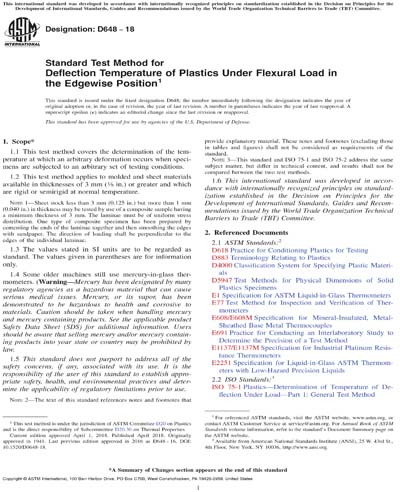Most recent
ASTM D648-18
Standard Test Method for Deflection Temperature of Plastics Under Flexural Load in the Edgewise Position
1.1 This test method covers the determination of the temperature at which an arbitrary deformation occurs when specimens are subjected to an arbitrary set of testing conditions.
1.2 This test method applies to molded and sheet materials available in thicknesses of 3 mm (1/8 in.) or greater and which are rigid or semirigid at normal temperature.
Note 1: Sheet stock less than 3 mm (0.125 in.) but more than 1 mm (0.040 in.) in thickness may be tested by use of a composite sample having a minimum thickness of 3 mm. The laminae must be of uniform stress distribution. One type of composite specimen has been prepared by cementing the ends of the laminae together and then smoothing the edges with sandpaper. The direction of loading shall be perpendicular to the edges of the individual laminae.
1.3 The values stated in SI units are to be regarded as standard. The values given in parentheses are for information only.
1.4 Some older machines still use mercury-in-glass thermometers. (Warning—Mercury has been designated by many regulatory agencies as a hazardous material that can cause serious medical issues. Mercury, or its vapor, has been demonstrated to be hazardous to health and corrosive to materials. Caution should be taken when handling mercury and mercury containing products. See the applicable product Safety Data Sheet (SDS) for additional information. Users should be aware that selling mercury and/or mercury containing products into your state or country may be prohibited by law.
1.5 This standard does not purport to address all of the safety concerns, if any, associated with its use. It is the responsibility of the user of this standard to establish appropriate safety, health, and environmental practices and determine the applicability of regulatory limitations prior to use.
Note 2: The text of this standard references notes and footnotes that provide explanatory material. These notes and footnotes (excluding those in tables and figures) shall not be considered as requirements of the standard.
Note 3: This standard and ISO 75-1 and ISO 75-2 address the same subject matter, but differ in technical content, and results shall not be compared between the two test methods.
1.6 This international standard was developed in accordance with internationally recognized principles on standardization established in the Decision on Principles for the Development of International Standards, Guides and Recommendations issued by the World Trade Organization Technical Barriers to Trade (TBT) Committee.
Content Provider
ASTM International [astm]






